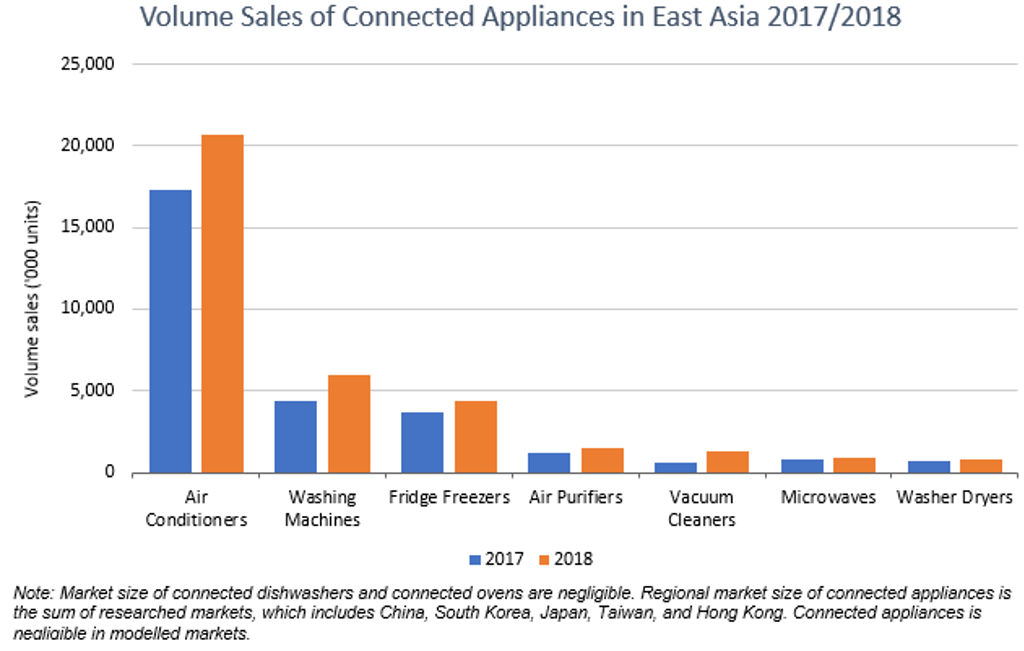East Asia, especially China, Japan and South Korea, is home to the most connected appliances in the world. The countries in the region have a desirable environment in which connected appliances can prosper with high internet access, high disposable income and consumer acceptance of the new technologies. However, each country in the region shows a different picture of connected appliance uptake. Increasing activation rates of connected appliances and lifting the security concern remain the key challenges for manufacturers in East Asia.
In East Asia, air conditioners is the product category with the highest number of connected products sold in 2017-2018. Air conditioners have good penetration in these markets due to the humid summers and worsening air quality, and consumers understand the benefit of remotely controlling their appliances outside the home. The high popularity of connectivity in air conditioners pushes manufacturers to incorporate connectivity in mid-priced and even low-priced models. In fact, Sharp announced that its entire range of air conditioners would be connected going forward, regardless of price point. Sharp may not be the leading company in the industry, but it is likely that its competitors such as LG, Panasonic and Midea will follow over time.
In China, the penetration of air conditioners well exceeded 100%, meaning that every household owns an air conditioner, usually located in the living room. Intense competition fuelled product innovation using connectivity and artificial intelligence. For example, Changhong’s KFR-72LW can be controlled by voice, offering greater convenience to consumers. Midea, on the other hand, offers a smaller second air conditioner, often installed in bedrooms. The model features Micky Mouse to attract parents with children. Micky Mouse is one of the favourite characters in China especially after Disneyland opened in Shanghai in 2016. The air conditioner is equipped with infrared sensing technology, allowing adjustment of room temperature depending on the child’s body temperature. The connectivity assures parents that the child’s room is comfortable, even when they are out.
Appliances in South Korea are more connected than in other countries in East Asia as of 2018. The South Korean government set the smart home as a main industry agenda for the future. As a result, Korea Association of Smart Home became an industry platform, where major players in home appliances, telecommunications and construction share their business plans to build up a smart home market strategy. Samsung and LG can now focus on connected appliances in their home ground. They advocate the benefits of the appliances in the media and at their flagship stores.
South Korean consumers are highly tech savvy and understand connected appliances, especially in that these appliances can reduce time spent on household chores such as cleaning floors and washing and drying garments. South Korea is also investing in the upcoming 5G technology. This new-gen connectivity infrastructure will aid the expansion of connected appliances over the forecast period.
Even in the most developed region for connected appliances, there remain challenges.
1. Interoperability with other manufacturers’ connected appliances
Most appliances still only work with smartphones. Some work with other appliances, but only from the same company. However, it is extremely rare for consumers to have appliances all from the same brand. Manufacturers need to work with each other or find a way to seamlessly communicate with each other so that consumers can enjoy the true benefits of connected appliances without having to purchase every appliance from a single brand.
2. Improvement of the activation rate
Even though the volume of connected appliances has been growing rapidly in the region, not all the connected appliances are activated. Some consumers purchase the connected appliances simply because there is no other choice. The low activation rate makes it difficult for manufacturers to obtain the big usage data, while consumers would feel that connectivity is not a necessity.
3. Affordability
More manufacturers such as Samsung announced that all their appliances to be connected within a few years. Despite efforts, the connected feature is somewhat limited to premium lines in most categories. Manufacturers need to lower the prices for connected appliances to encourage more consumers to use connected appliances in order to better develop features.
4. Security concerns
Consumers generally have concerns over security when it comes to connected devices, because they are not fully aware how manufacturers treat their personal information as well as the application they use with such information. Manufacturers are encouraged to disclose what they do with proprietary information and how this information helps make consumers’ live more simple, when used with connected appliances.

